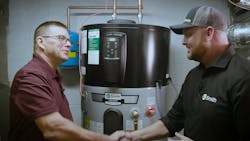The push toward electrification isn’t necessarily an inexpensive one, from an upfront investment in equipment and installation, that is. But the story for heat pump water heaters (HPWHs) is payback, and the associated rebates and tax credits that may come with it.
Having said that, how can rebates/tax credits alleviate some of the consumer purchasing burden for heat pump water heaters? “There is a definite push in regions and markets where the reduction of the carbon footprint is a major priority,” says Randal Oshiro, Engineering Manager, Noritz. “However, these programs are not universal and the experience for end user will vary significantly by region and utility. The accessibility and ease of these programs have positive correlation with heat pump adoption within the regions.”
Oshiro also emphasizes that rebates and tax credits often provide strong assistance to customers in the transition provided they are simple enough to navigate and major infrastructure work is not necessary. “However, for families where the power infrastructure requires major overhaul, the rebate does not make too much of a dent into the extra costs and time incurred, especially in situations where hot water is an immediate need (emergency replacement),” says Oshiro.
Added to that, “Most rebates are midstream and taken at point-of-sale in many markets, and contractors may not be aware these exist. For example, at the checkout of a big box store, the units get marked down by the rebate amount so it makes the transition to high efficiency electric equipment easier for the consumer,” says Eric Ashley, Senior Product Development Manager, Noritz.
ROI
But it usually comes back to the return on investment, doesn’t it? “The story for heat pump water heaters is really payback,” says Gregg Holladay, Business Development Manager – Specialty Markets, Bradford White Corporation. “A water heater that provides up to $4.00 in hot water for every $1.00 spent saves the homeowner not only 3,000 kWhs per year, but also about $400 in operating cost as compared to a standard electric tank. Add a significant utility rebate, about $750 in some markets, plus up to $2,000 in tax credit, and the payback is very fast on a product with a 10-year warranty,” continues Holladay.
In addition to federal incentives, various states, localities, and utility companies extend rebates and incentives to promote the adoption of these environmentally friendly water heaters. Together, these financial incentives not only lower the initial investment cost but also contribute to long-term savings on energy bills. Bradford White has a rebate finder on our website so anyone can find rebates and tax credits using their zip code. You can search for available rebates and tax credits in your area at forthepro.bradfordwhite.com/product-rebates-tax-credits.
“We also teach/train contractors on products and remind them of what is available in their market on a regular basis. Our job is to equip them with knowledge and expertise so they are confident talking to homeowners,” says Holladay.
The Role of Utilities
Furthermore, a large number of utilities and energy organizations offer rebates on heat pump water heaters across the country. “The most effective to influence the consumer’s purchase decision are instant rebates that the contractor can offer on invoice,” says Francois Lebrasseur, Market Development Manager - Utility Segment, A. O. Smith.
According to Lebrasseur, there is a 30% Federal tax credit on HPWH in 2025 (up to $2,000) on the project cost—product + installation—net of local incentives. Some States (NY, WI, GA, NC) have rolled out the Inflation Reduction Act Home Electrification and Appliance Rebates (HEEHRA) discounts for low- and medium-income customers that include a discount for HPWH, up to $1,750. (Resource: https://www.hotwater.com/water-heater-rebates.html)
Lebrasseur says that normally the utility rebates are established for each calendar year and applied to purchases that year. “The Federal tax credit is in place as is for product purchases in 2025. The Inflation Reduction Act HEEHRA programs are implemented by each State energy office with various timetables and program designs,” says Lebrasseur.
Eligibility Criteria
To tap into the savings of heat pump water heaters, it’s crucial to understand the eligibility criteria for both tax credits and rebates. Generally, for the federal tax credit:
• The heat pump water heater must be installed in a primary or secondary residence located in the U.S.
• It must meet specific energy efficiency criteria set by the Department of Energy. Learn more about the Heat Pump Water Heaters Tax Credit at www.energystar.gov/about/federal-tax-credits/heat-pump-water-heaters.
For rebates, criteria can vary widely depending on the offering entity. Common qualifications include:
• Purchasing and installing equipment within a certain timeframe.
• Buying a model that meets certain ENERGY STAR® or energy efficiency qualifications. Learn more about ENERGY STAR® certifications for heat pump water heaters here.
• Residency within a specific location or utility service area.
(Source: Bradford White Corporation)
How to Claim
Claiming these incentives doesn’t have to be a complex process:
• Documentation is Key: Keep all receipts and manufacturer’s certificates for the heat pump water heater, as they typically contain information about energy efficiency.
• IRS Form 5695: For federal tax credits, fill out IRS Form 5695 and submit it with your tax return. This form is specifically designed for residential energy credits. Learn more about this form at www.irs.gov/instructions/i5695.
• Utility and State Rebates: Check with your local utility company or state energy office for applicable rebates. They often have a separate application form and may require a copy of your sales receipt and installation certificate.
• Deadlines Matter: Be aware of deadlines for both tax credit and rebate applications, as missing these can disqualify you from receiving the incentive.
(Source: Bradford White Corporation)
